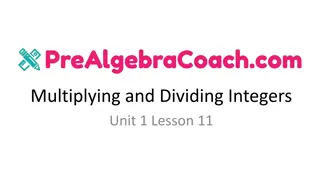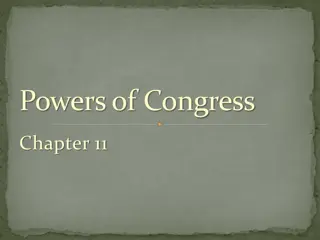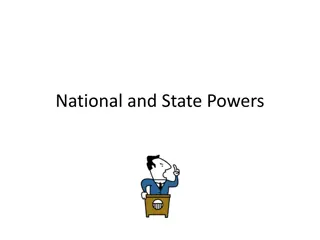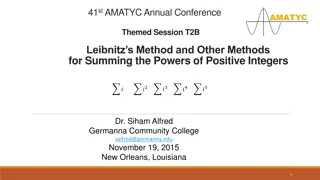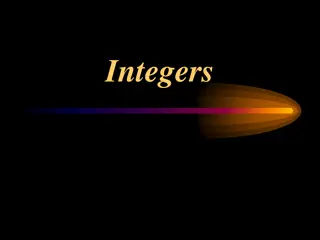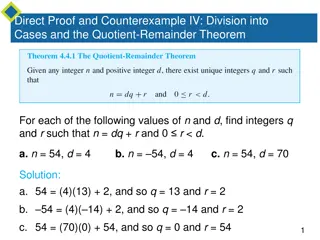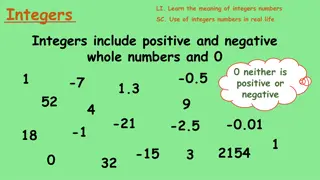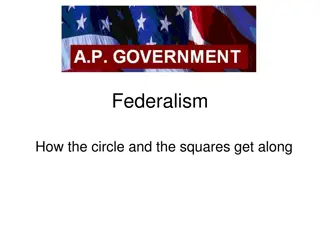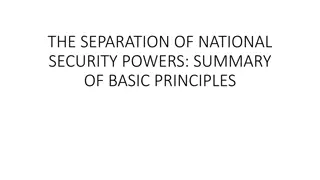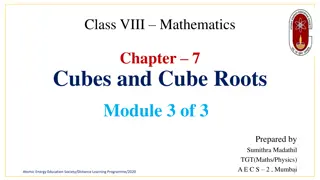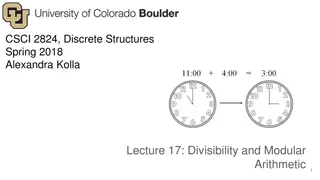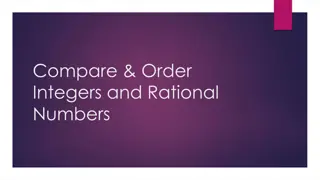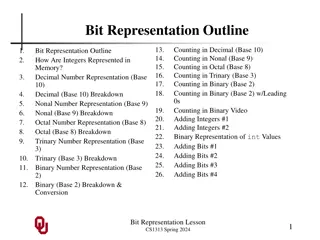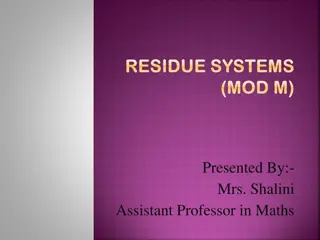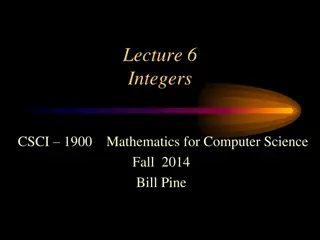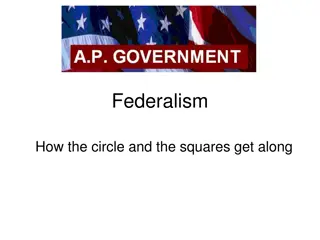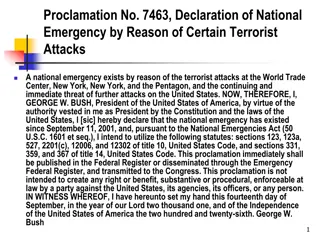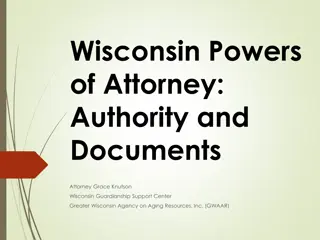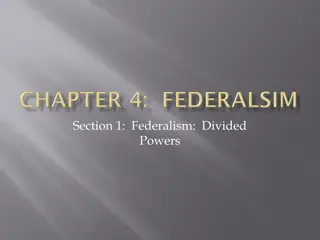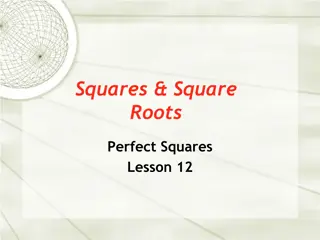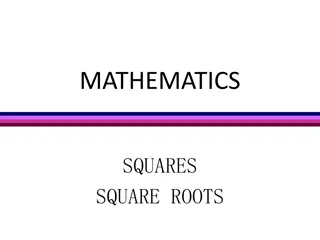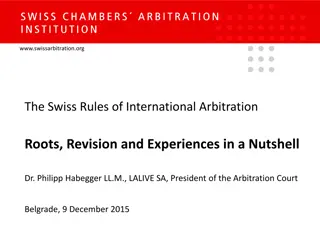Understanding Integers, Powers, and Roots: A Comprehensive Guide
Explore the world of integers, powers, and roots in this educational chapter. Learn how to multiply and divide integers, calculate squares and square roots, understand laws of indices, and master the order of operations. Discover concepts like LCM, HCF, prime factorization, natural and rational numbers, and more through examples and exercises. Delve into the realm of square numbers, square roots, and their applications in everyday scenarios like finding areas of squares and converting decimals to fractions.
Download Presentation

Please find below an Image/Link to download the presentation.
The content on the website is provided AS IS for your information and personal use only. It may not be sold, licensed, or shared on other websites without obtaining consent from the author. Download presentation by click this link. If you encounter any issues during the download, it is possible that the publisher has removed the file from their server.
E N D
Presentation Transcript
Integers, powers and roots Integers, powers and roots Chapter 1
Objectives Objectives To learn about multiplying and dividing integers. To learn about squares and square roots, cubes and cube roots. To learn about laws of indices. To learn about the order of operation. To learn about LCM,HCF and prime factorization. To learn about natural and rational numbers.
Multiplying and dividing negative numbers + = Different signs /negative answer + = = + + + = + Same signs /Positive answer = + + + = + https://www.youtube.com/watch?v=K_tPbVPfHgk
Examples 100 25 = 28 7 4= 4 6 3 2 = 36 9 = 4 20 5 = 4 10 4 8 60 5 3 5 4 = =
Examples: find the missing number: ___ 5 = 30 6 ___ 6 = 42 7 ___ 6 = 48 8 2 ___ 6 = 36 3 3 5 ___= 75 3 5 ___= 75 5 Solve the following: P. 10 Ex. 1B Q2 (f,g,h,j,k), Q3 (c,d,f,h,i), Q4 (b,d,f,h), Q5(d,e,f), Q6(a,c,g,h), Q7 (all). Q8, Q9. P. 11 Ex. 1C Q2(c,d,e), Q4, Q5, Q6(a,c,g,h), Q7, Q8, Q9(a,c), Q10. ___ 4 2 = 72 9
Squares numbers Square numbers come from squaring integers (multiplying a whole number by itself) Example: 2 2 = 4 and 4 4 = 16 This can be written using indices 22 = 4 and 42 = 16 Note: 2.72= 2.7 2.7 = 7.29 which is not a square number because 2.7 is NOT an integer
Square roots Finding a square root of a number is the inverse of squaring a number. Example: 49= 7 because 7 7 = 49 so 49 = 7 Note: you also know that 7 7 is also 49 Therefore, 49 = +7 and 7
Square roots continue Example: Find the square root of the numerator then the denominator. Example: Convert decimals to fractions then find their square roots Example:
Area of a square = l w Example 1: what is the area of the square below: Example 2: what is the side length of the square below: In the above square we know that the area is found by multiplying a number by itself to get 441 cm2. Since the inverse of squaring a number is the square root, the side length of the square = 441 = 21 cm Since the side is known and a square has 4 equal sides, the area of the square = 5 5 = 25 cm2
Cubes Cube numbers come from cubing integers (multiplying a whole number by itself and then multiplying by itself again) Example: 2 2 2 = 8 and 4 4 4 = 64 This can be written using indices 23= 8 and ( 4)3= 64 Note: 3.13= 3.1 3.1 3.1 = 29.791 which is not a cube number because 3.1 is NOT an integer
cube roots Finding a cube root of a number is the inverse of cubing a number. Cubes and cube roots are useful for finding volumes and side lengths of cubes Example: = 5 5 x 5 x 5 = 125 so = 5 = 2 Example: The answer is 2 because 2 2 2= 8
Volume of a cube = l w h Example 1: what is the volume of the cube below: Example 2: what is the side length of the cube below: Since the inverse of cubing a number is the cube root, the side length of the cube is = = 5 m Volume = l w h = 3 3 3 = 27 cm3
Solve the following questions: P. 13 Ex. 1D Q1 (a, b, f) Q2 (a, d, f) Q3 Q4 (a,b) Q5 (b,c,f) Q6 (b, d) Q7 (a, b) Q8 (a,c) Q9 (a,c) Q10 Q11 Q13 (a,b) Q14 (b,e) https://www.youtube.com/watch?v=B4zejSI8zho
Index notation Index notation means using powers. Example: 2 2 2 = 23 5 5 5 5 = 54 7 7 7 7 7 7= 76 Solve P.14 Ex. 1E Q1 (c, d), Q2 (b, d, e), Q3 (b, c,e), Q4 https://www.youtube.com/watch?v=-zUmvpkhvW8
Multiplying powers of the same number When two numbers are powers of the same number (same BASE), you multiply them by adding their indices. Using symbols: ?? ??= ??+? Example: ?? ??= ??+?= ?? 5 5 5 5 5 5 5
Dividing powers of the same number When two numbers are powers of the same number (same BASE), you divide them by subtracting their indices. Using symbols: ?? ??= ?? ? Example: ?? ??= ?? ?= ?? 5 5 5 5 5 5 5 5 5 5 5
Solve the following questions: P. 15 Ex. 1F Q1 (b,f) Q2 Q4 Q5 Q6 (b) Q7 Q8 Q9 (a,d) Q10 (a,d) Q11(g,h,i,j)
Lowest common multiple LCM (lowest common multiple of two or more numbers is the common multiple with the lowest value.
Highest common factor HCF (highest common factor) of two or more numbers is the common factor with the highest value. Factors of a number are the whole numbers that divide into it with no remainder. It s a good idea to look for factors in pairs, so that you don t miss any out. Example: Find the HCF of 20 and 24: Factors of 20: 1 , 2 , 4 , 5 , 10 , 20 Factors of 24: 1 , 2 , 3, 4 , 6 , 8 , 12 , 24 Common factors are: 1 , 2 , 4 Highest Common factor is: 4 Solve P. 16 Ex. 1G Q1 (b), Q2 https://www.youtube.com/watch?v=0NvLtTwnUHs &list=PLbzagEi1JQaMR8nAaTKzcjRkrhnYx4SdH
Prime numbers A number that has two factors only, 1 and itself is called a prime number. A number that has more than two is called a compositenumber. Every number can be written as a product of prime. The two most common ways to do this are by using factor trees and division by primes. 120 = 2 2 2 3 5 Using index notation: 2 80 = 2 2 2 2 5 Using index notation: 2 3 3 5 4 5 https://www.youtube.com/watch?v=XGbOiYhHY2c&list=PLbzagEi1JQaMR8nAaTKzcjRkrhnYx4SdH&index=3
Finding LCM and HCF using factor tree or division by prime HCF 12= 2 2 3 = 22 3 16 = 2 2 2 2 = 24 circle the common numbers and use one from each group or use the lowest power of common factors HCF = 22 = 2 2 = 4 LCM 12= 2 2 3 = 2 16 = 2 2 2 2 = 2 Put the common numbers in groups, take one from every group and collect any left over numbers as well. OR: Use the highest power of All numbers. 2 3 4 4 3 = 48 LCM = 2 Solve P. 18 Ex. 1H Q1,Q2 ,Q3(a,c), Q4(c,d), Q5 (a,b)
BIDMAS When there s multiple operations in a question you should ALWAYS follow the correct order of operation. Watch the link below: https://www.youtube.com/watch?v=dAgfnK528RA Solve P. 19 Ex. 1I Q1, Q2 (b, c, d), Q3 (b, c), Q4, Q5 (a), Q6(c), Q7(a)
Remember. Know your square numbers up to 20 x 20 Know your cube numbers up to 10 x 10 x 10
Natural and rational numbers Natural numbers: are number you use to count (they are positive whole numbers not including zero). 1, 2, 3, 4 Whole numbers: are natural numbers including zero. 0, 1, 2, 3, ... Integers: are positive and negative whole numbers including zero. .-3, -2, -1, 0, 1, 2, 3, ... Rational numbers: can be made by dividing two integers. They include: Fractions ( 1 4 , 321 758 ) Solve P. 20 Ex. 1j Q2, Q4 Decimals (terminating and recurring)



